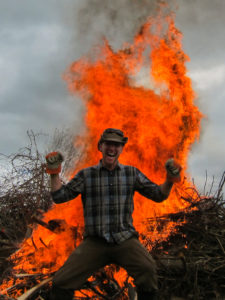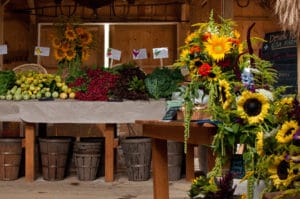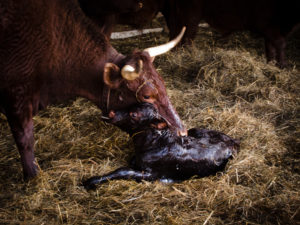Using Photographs to Market Your Farm

Photos taken of summer flowers can be used to market Flower CSA shares in the winter when nothing is in bloom. Farmer Patty Taylor was standing in the shade to give an even light on her face while the background is slightly over-exposed and “blown out” to give a good depth of field. Photo by John Suscovich
We’ve all heard that a picture is worth a thousand words. So, by that math, you can write a 10,000 word article about your farm in ten photographs. Wouldn’t it be nice to easily show your customers just how awesome you are without having to write a novel in your “free time”?
Your average consumer today is well-connected, in the know, and eager for more information about their interests. Digital cameras and the world wide web makes it easier than ever to reach out to your customers almost instantly and, in doing so, build value into your products and your business.
With today’s technology growing by leaps and bounds, the size of cameras is decreasing as fast as the quality is increasing. The other side effect of a market flooded with good cameras is that they are very affordable. You do not need a four pound DSLR camera with three lenses and an elaborate tripod to capture your farm in the best light. You can take high quality photographs with your cell phone, or a camera that is not much bigger.
Reach Your Audience Like Never Before
Even in the world of slow food, life is still pretty fast paced. As a farmer you are constantly racing to beat the weather, catch up on record keeping, and get the tractor fixed for the hundredth time. As a consumer, you are bringing the kids to after school activities, trying to figure out what to cook with your weekly CSA vegetables, or just like farmers, doing your best to catch up with paying the bills. By sharing your farms’ story with photographs you allow that consumer to digest your update quickly by scanning the pictures, or slowly by taking time with each photograph and reading the captions beneath each photograph. Photographs also save you time as a farmer by relieving you of time spent writing and editing a detailed update for your news-hungry fans.

The more interesting and zany the photo, the more reaction it will elicit. This spring when we were cleaning hedgerows and burning brush I took this self-portrait in front of one of our fires. It was the most talked about photo of the farm season. Photo by John Suscovich
The wonderful thing about digital photographs is that they last forever (baring any tragedy to your computer, please back-up!). Those quick snapshots you took of your CSA pick-up, your cattle in the fields, or your pumpkin patch will serve as marketing materials for years to come. You can add them to your business flier, post them on your website, add them into your newsletter, and submit them to magazines, all to draw attention to your farm.
Make the Investment
Marketing is as important to your farm business as putting seeds in the ground or managing your pasture. Just like planting, marketing takes a little time and a little money. Time to learn the best way to use your camera, keep your photographs organized, and time to put photographs where your customers are going to see them. Also a little money invested in a decent camera or phone.
While the investment of time and money may hurt a little up front, it will pay off when your farm gains recognition, you have a higher customer retention for your CSA from year to year, and you can charge prices that are more fair to you because you have built value into your products through your photos.
Camera Suggestions
On the high end, I would go with a Canon PowerShot s100 ($379 online). I use this camera as a professional photographer when I am not carrying my clunky DSLR. On the farm, I carry it in a case on my belt behind my back. The case keeps it relatively clean, and handy to reach for grabbing quick pictures on the farm. On the low end, search ‘Nikon Coolpix” online. Prices range from $20-$60 depending on special offers.
I trust B&H for all my geek equipment needs. They almost always have the best prices, and always have the best customer support and knowledgeable staff. I buy a lot from them.

Photos of the CSA pick-up during the bounty of the season can be used all year, and for years to come to give customers a visual of what our CSA pick-up looks like. Note: I knelt on one knee to give a different angle and compose the photo to contain the flower share, vegetable shares, farm name, and beautiful white oak barn. Photo by John Suscovich
Software Suggestions
On the high end, I use Adobe Lightroom ($129.95 from BH Photo, $149 from adobe). There is a little bit of a learning curve using this software. I use it almost every day and I love it. There are a lot of free tutorials online. On the low end, I would use iPhoto for Mac (free) and Picasa for PC (free download). Each will get you up and running quickly with uploading, organizing, and sharing your photos.
Quick Tips For Better Photographs
Framing. Follow the rule of thirds. Your photograph is a rectangle. Divide that rectangle into three horizontally, then vertically. Those four dividing lines (two vertical, two horizontal) will give you four intersections. Place your subjects on one of those intersections. This can give your photograph direction as well as make it more dynamic and interesting. You want to avoid photos where the subjects head is at the bottom or middle of the picture with a million feet of head space above them.
Interest.
You see the world from one vantage point, your own. Somewhere around 4’6″ to 6′ high, and at a comfortable distance. To add interest to your pictures get up close and personal, take them seated very high up (get on the roof), or very low to the ground. Looking at the world from a different perspective will give your photos interest and attract more attention.

Having my camera handy and on my belt helped to ensure I did not miss any of the special moments on the farm. This calf was born on the other side of the farm from the farm house. I was there to help deliver and capture the moment. Our CSA members loved seeing the new calf and how it helped them connect to the farm. Photo by John Suscovich
Lighting.
Where is the sun? Are you inside? If so, where are the light sources? Lighting is a HUGE factor in photography. When shooting indoors, beware of low-light that will blur your images. When shooting in direct sun, be aware of harsh shadows on people’s face that make them less attractive. You can save a picture by asking the person to turn a little. Here’s a hint, shoot the picture with them in the shade of a tree or building with their back facing a bright background. They will have even light on their face, while the background will be slightly over-exposed (too bright) bringing the focus to the persons’ face.
Keep Shooting. Keep shooting! Good or bad, the only way you learn is to keep doing it. Your pictures might be terrible in the beginning, but learn from them. What is wrong? How can you do it better next time? Ask others for advice. The only bad picture is the one you did not take. Digital photography lets you keep shooting cheaply.
Don’t Go It Alone
Today everyone has a camera. As a farmer, you do not have to be the only one taking photographs of your farm. More importantly, your job is to make your farm and your farm products “picture-worthy”. As a farm apprentice at Devon Point Farm in Woodstock, CT, I had no trouble finding my share of photo-ops because farmers Erick & Patty Taylor invested their time and energy into making their farm neat and beautiful, and their produce healthy and bountiful. I was not the only one with a photographic eye for their farm. While I was there, they were featured in Edible Nutmeg (my photographs) and twice in Foodies of New England Magazine. Which leaves me with a phrase to share: “If you build it, they will come… with cameras.”
For more information on marketing your farm please visit Farm Marketing Solutions to download your free copy of our e-book Farmers’ Guide to Increasing Profits.


Good article!!
Im pretty frugal, being a small farmer and all. I found that Pawn Shops arent putting value on point and shoot cameras. There is so much focus on DSLR cameras. I personally have a Nikon D80, but I picked up a Nikon point and shoot for $26. Dont always assume you must pay retail for anything. I was in a thrift store buying work tshirts when I looked down and found a furrowing plow for $15. I really believe that if you keep your list of what you need or want, you will just stumble upon it.
Thank you for the article. 🙂